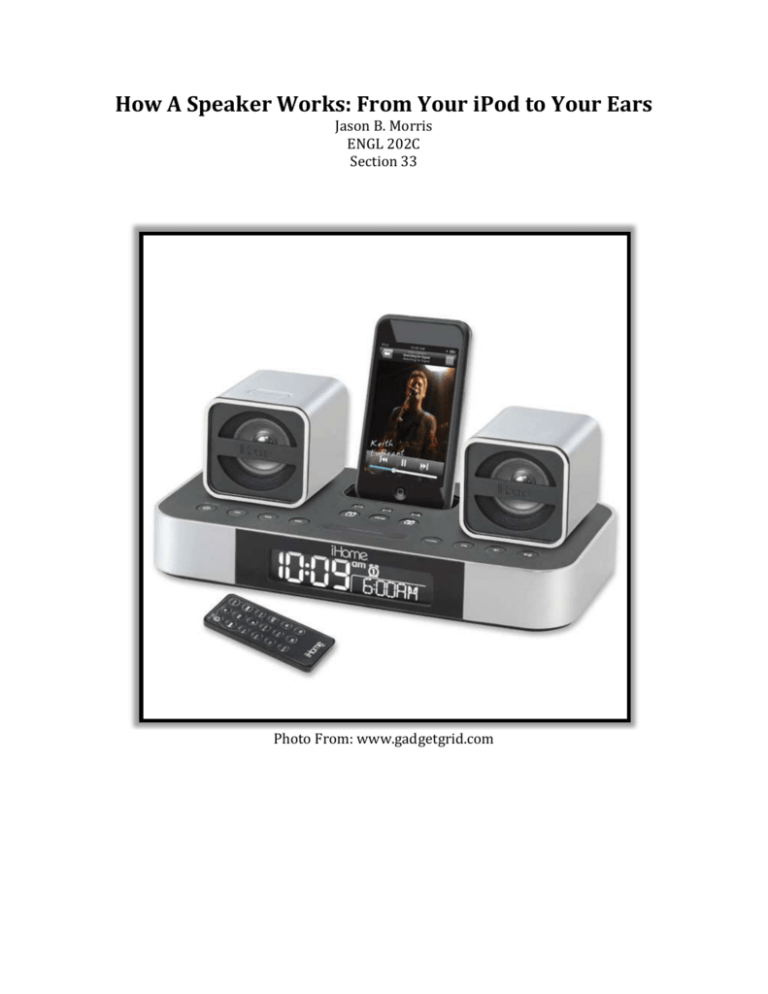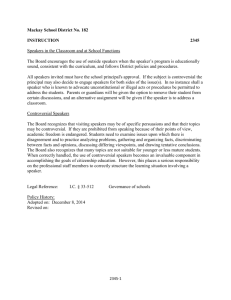Morris_TDD - Personal.psu.edu
advertisement

How A Speaker Works: From Your iPod to Your Ears Jason B. Morris ENGL 202C Section 33 Photo From: www.gadgetgrid.com Audience and Scope The purpose of this document is to provide the audience with a general understanding of how a speaker works, and the physical concepts employed in speaker design. This document will focus on the function of a general, dynamic speaker rather than a specific product (such as an iHome). This is the most commonly used type of speaker and almost all other types of speakers function under the same principles. Audio companies simply utilize these principles and tweak their speaker design so as to have their own product line. Company ownership also makes it very difficult to gain insight as to how a specific product is designed and functions. However, after reading this document, the audience will understand exactly how the speakers work in almost all of their everyday electronics such as computer speakers, headphones, and even cell phones. The intended audience for this document is upperclassman high school students with an interest in the Science, Technology, Engineering and Math (STEM) fields. This document will make clear connections between the concepts that may be learned in STEM related courses and how you can use these concepts to create technical products. This understanding of creating advanced technology using fundamental concepts will give the audience a better idea of the things they can accomplish with a career in the STEM fields. An Introduction to Speakers A speaker is an electro-mechanical device that converts an electrical signal (voltage and current) to sound. The electrical signal can come from almost any electronic device: a computer, an iPod, a television, or even a phone. Figure 1 illustrates the role of a speaker in the creation of sound. Electrical Signal (From iPod) Speaker Converts Electrical Signal to Sound We Hear Music Figure 1: The Role of the Speaker (Photos from www.kpsec.freeuk.com/acdc and www.europe-audio.com) Fundamentals of Sound In order to understand how a speaker works, we need to discuss a few basic concepts of sound. Sound is a wave (the displacement of a medium), much like the type that is created in water when you throw a stone into a lake. However, instead of traveling through water, sound waves travels through air. Sound waves differ from most other waves in that they are longitudinal waves. This means that the displacement of the medium is parallel to the direction that the wave is traveling. This is unlike a transverse wave that is created when a stone is thrown in water, where the displacement is perpendicular to the direction of wave travel. The difference can be seen in Figure 2. 1) Longitudinal Wave (Sound) 2) Transverse Wave (Water) Figure 2: Longitudinal and Transverse Waves (Image from www.mediacollege.com) For a Better Understanding: Wave motion is much better understood through visual demonstrations. The Penn State Acoustics Program has put together an excellent visual demonstration of the different wave motions at: http://www.acs.psu.edu/drussell/Demos/waves/wavemotion.html As you can see in Figure 2, sound waves consist of the rarefaction (spreading out) and condensation (squishing together) of air molecules. In order to accomplish this, we need something to “push” the air particles, which is exactly what speakers do. Speaker Composition Speakers are composed of multiple parts that are specifically designed and constructed for the purpose of pushing air particles. Although there are many types of speakers now due to advancements in materials and technology, the most commonly used is the dynamic speaker. The dynamic speaker is characterized by its use of a driver (a magnet and copper-coil combination), which controls a diaphragm that “pushes” the air. All of the speaker components are broken down and explained in figures 3 and 4. Figure 3: External Speaker Components (Image courtesy of www.howstuffworks.com) 1) Basket: Provides the framework for mounting all the speaker components 2) Suspension: Connects the diaphragm edge to the basket and allows for controlled diaphragm motion 3) Diaphragm: Rigid material that pushes the air to create the sound wave 4) Dust Cap: Completes the seal of the diaphragm and prevents particles from getting inside the speaker Figure 4: Internal Speaker Components (Image courtesy of www.howstuffworks.com) 5) Spider: Provides a restoring force for the diaphragm and centers the voice coil 6) Driver (Voice Coil/Magnet): These two components combine to essentially make a motor that drives the speaker. The magnet is stationary and Why it Works: The driver (voice coil/magnet combination) can be a tricky concept to grasp. It works because of a physics concept called the Lorentz Force Law. This states that when an electric current moves through a wire that is placed within a magnetic field, a force is created. Therefore, when our electrical signal (current) runs through the voice coil, a force is generated and the voice coil moves the diaphragm. The diaphragm in turn “pushes” the air particles creating sound. Figure 5 illustrates the Lorentz Force. Note that since our magnet is stationary, only the direction of the current dictates the direction of the force. This means that the voice coil and diaphragm will move in exact coordination with our electrical signal. Figure 5: Lorentz Force (F) Explanation. L represents the length of the wire. (Image from http://hyperphysics.phy-astr.gsu.edu) the voice coil moves the diaphragm. With a basic understanding of the concepts of sound waves and the Lorentz force, you’re already equipped with all the tools necessary to build speakers. These are the critical elements of speaker design. However, with technology advancements and innovative thinking, engineers and scientist have learned that there are quite a few things to keep in mind when making speakers. Size Does Matter, But That’s Not All In general, the size of the speaker usually dictates the types of sounds that we hear from that speaker. For example, a very large speaker will generate very low frequencies (bass). Conversely, a very small speaker is best for high frequencies (high pitches). However, we can compensate for this in many ways. One way is by altering the location of the speaker. This can mean simply moving the location of the speakers relative to each other, or even altering the distance from our ears to the speakers altogether. For example, if we want really small speakers for mobile applications, we can simply bring them closer to our ears and we will get more frequency content (a wider range of pitches). This is what allows us to have earphones and cell phones. We make miniature speakers and stick them right in your ears. \ Figure 6: Earphones Are Speakers in Your Ears! (Image courtesy of www.shopmedacou-stics.com) Another compensation method is by the use of software. With the miniaturization of circuit elements entering the nano-scale, we can now have entire Integrated Circuit (IC) chips that are so small, they fit in our ears. These ICs are programmable through computer software. What this means is that we can make our speakers act almost like a computer and add missing elements. In other words, if a song doesn’t have too much bass, we can program the speaker to add more. Speakers can be programmed to remove sound as well. This can be used in loud environments such as busses or airplanes, where the speakers will remove the excess noise and you will only hear the sound of your music. Speakers that add or remove content are called active speakers. We can have active speakers for an entire range of frequencies, which allows us to make high quality speakers of all shapes and sizes. Conclusion Speakers are designed to take an electrical signal and convert it to sound by pushing air particles. They do this by using a driver that consists of a moving copper coil (voice coil) and a stationary magnet. By utilizing the Lorentz Force, the coil moves in exact coordination with the signal, and pushes a rigid diaphragm accordingly. This diaphragm physically pushes the air and the result is audible sound. Speakers can be found in many of our electronics today and the vast majority of them utilize these same principles. References Most of the knowledge in this paper has come from my years of involvement with the Audio Engineering Society (AES). Other references are below: http://electronics.howstuffworks.com/speaker.htm http://www.acs.psu.edu/drussell/Demos/waves/wavemotion.html http://www.kpsec.freeuk.com/acdc.htm http://hyperphysics.phy-astr.gsu.edu/hbase/audio/spk.html





